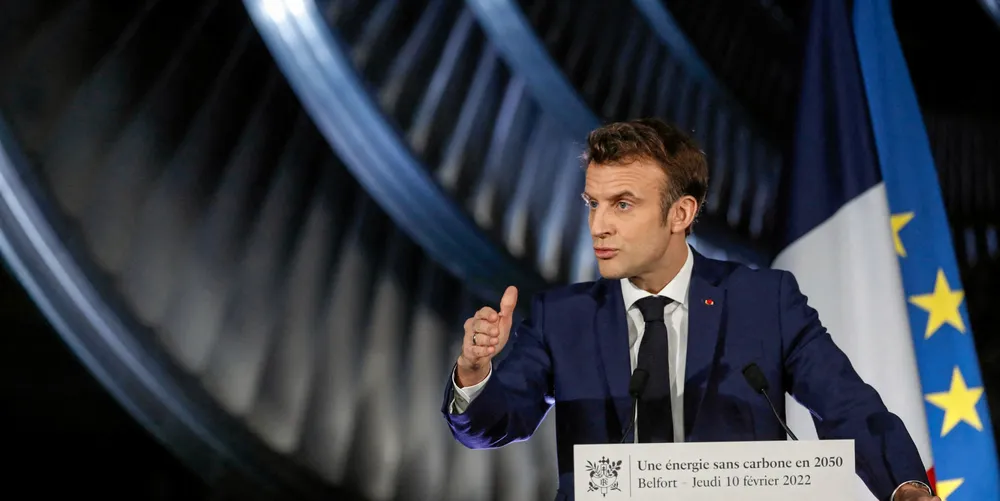'Fifty offshore wind farms by 2050' | France plans massive sea and nuclear power build
President Emmanuel Macron also sees room for ten-fold solar expansion but puts brakes on onshore wind caving in to far-right opposition

France will massively expand offshore wind, nuclear and solar power by mid-century to reach its climate targets amid rising electricity consumption – but put a brake onshore wind development, President Emmanuel Macron announced.
In a speech with nationalist overtones, the French leader also partly caved in to aggressive demands from the far-right opposition against wind on land as the country’s presidential election campaign heats up.
France will build ‘50 offshore wind farms by 2050’ that have a combined capacity of 40GW, Macron said at a factory producing giant turbines for nuclear reactors in the eastern town of Belfort.
France so far has no commercial wind farm in operation in its waters, but Macron nevertheless radiated confidence and patriotic pride during his speech (in front of a French flag mostly covering a European flag behind it). While officially talking about ‘zero carbon energy in 2050’, he sounded in full election campaign mode.
The liberal president hasn’t officially declared he will run for re-election in April, but is leading in all opinion polls, trailed by three candidates that range from very conservative to the extreme far-right.
“This year, we will commission the first offshore wind farm off Saint Nazaire,” he stressed, claiming that France’s emerging offshore wind industry in the northern French port town, as well as in Le Havre and Cherbourg, will be able to supply all the necessary components for the massive expansion plan, as well as create jobs.
Despite holding first tenders for about 3GW of wind at sea, France’s offshore wind programme for years has been plagued by lengthy court challenges, administrative hurdles, abrupt policy changes and protests by fishermen.
To avoid more hiccups, the government in future planning wants to involve fishermen, set clear rules and take into account all maritime interests, Macron pledged.
France's current formal goal is 6.2GW by 2028 under its multi-year energy plan.
'Solar easier on landscape'
As for renewables on land, the government wants to give priority to solar, which is “cheaper and easier to integrate into the landscape”, the president said, announcing a special effort to grow the country’s PV capacity almost tenfold to pass 100GW by 2050. Macron also pledged to help the solar industry come back to Europe and France after most manufacturing had been lost to Asian countries, mostly China.
While the wind sector applauded the plans for a massive offshore wind expansion, it was appalled by Macron’s plans to slow down onshore wind development.
Saying he understood controversies over new onshore wind projects, Macron said Paris has re-thought targets for wind on land, and now plans to only double the country’s onshore wind capacity by 2050, from around 18.5GW at the end of last year.
“It is possible to reconcile wind development with landscape protection, and our natural and cultural heritage,” was how Macron justified the intended slow expansion.
Far-right pressure
Macron was at least in part caving in to demands by the extreme right to end onshore wind construction. Several well-known political figures in France are advocating a moratorium on new projects, while far-right candidate Marine Le Pen, one of Macron’s main opponents in the presidential campaign this year, has even lobbied for a dismantling of existing ones.
Turbines in new wind farms will be bigger and fewer, more geographically dispersed, and not concentrated on some regions like Haute de France, Macron also promised.
“The volumes and the rhythm [of expansion] proposed for onshore wind power are clearly out of step with the needs of our country,” said Anne-Catherine de Tourtier, president of France’s national wind association FEE, calling on Macron to reconsider the onshore wind target.
“RTE's [France’s grid operator] work clearly demonstrates that by 2035, onshore wind power is the most efficient and pragmatic solution to deploy.”
“But the volumes proposed for onshore wind are inconsistent with a rapid energy transition. Onshore wind is cheap and scalable. It is the fastest way to produce large amounts of additional renewable energy.”
Other European countries have successfully shown how to reconcile onshore wind, biodiversity and public acceptance, Dickson pointed out, adding that France had already made good progress in this area.
“The government has recently agreed 10 measures for the 'responsible development' of onshore wind. The latter provide a good basis for the further expansion of onshore wind in France.
“But President Macron’s plans fail to reflect the huge potential of onshore wind for France’s energy transition.”
25GW of new nuclear
Last but not least, the French president also announced the country – with the help of heavily indebted state-controlled utility EDF – will build six new nuclear power plants of the European Pressurised Reactor (EPR) type, and possibly another eight small modular reactors (SMRs). Together those should add “25GW in new nuclear capacity by 2050”.
While SMRs so far are an unproven technology (despite being hyped by investors such as Bill Gates), France already has experience with the EPR, but so far a very costly one.
The president also announced that, where ever possible, the operating life of old nuclear power stations should be extended. It remains to be seen how realistic that is. EDF earlier this week said it will temporarily shutter eight reactors due to corrosion in pipes.
Macron in Belfort ridiculed leftist opposition reservations about the pricey nuclear adventure, as well as safety concerns, and said his energy plans “will make France the first large country in the world to exit its dependence of fossil energies in 30 years, and reinforce our energy and industrial independence.”
(Copyright)